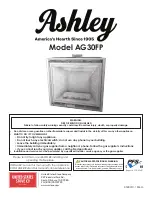
51
Hearth & Home Technologies • DVLINEAR36 Installation Manual • 2569-980 Rev. E • 11/20
C. Gas Connection
• Refer to Section 3 for location of gas line access in
appliance.
• Gas line may be run through knockout(s) provided.
• The gap between supply piping and gas access hole
may be sealed with caulk or aluminum foil tape with a
minimum of 300 ºF continuous exposure rating or stuffed
with non-combustible, unfaced insulation to prevent cold
air infiltration.
• Ensure that gas line does not come in contact with outer
wrap of the appliance. Follow local codes.
• Pipe incoming gas line into valve compartment.
D. High Altitude Installations
NOTICE:
If the heating value of the gas has been reduced,
these rules do not apply. Check with your local gas utility
or authorities having jurisdiction.
When installing above 2000 feet elevation:
• In the USA: Reduce input rate 4% for each 1000 feet
above 2000 feet.
• In CANADA: Input ratings are certified without a
reduction of input rate for elevations up to 4500 feet
(1370 m)above sea level. Please consult provincial and/
or local authorities having jurisdiction for installations at
elevations above 4500 feet (1370 m).
Check with your local gas utility to determine proper
orifice size.
Figure 9.4 Incoming Gas Line Location
• Connect incoming gas line to the 1/2 in. (13 mm) NPT
connection on manual shutoff valve.
WARNING! Risk of Fire or Explosion!
Support control
when attaching pipe to prevent bending gas line.
WARNING! Risk of Fire or Explosion!
Gas build-up
during line purge could ignite.
• A small amount of air will be in the gas supply lines.
• Ensure adequate ventilation.
• Ensure there are no ignition sources such as sparks or
open flames.
Light the appliance. It will take a short time for air to purge
from lines. When purging is complete the appliance will
light and operate normally.
WARNING!
Risk of Fire, Explosion or Asphyxiation!
Check all fittings and connections with a non-corrosive
commercially available leak-check solution.
DO NOT
use
open flame. Fittings and connections could have loos-
ened during shipping and handling.
Note:
It is important to plumb the incoming gas line to
the location specified inside the appliance. This specific
location allows for future serviceability of the appliance.
See Figure 9.4
















































